Letter from the Hill
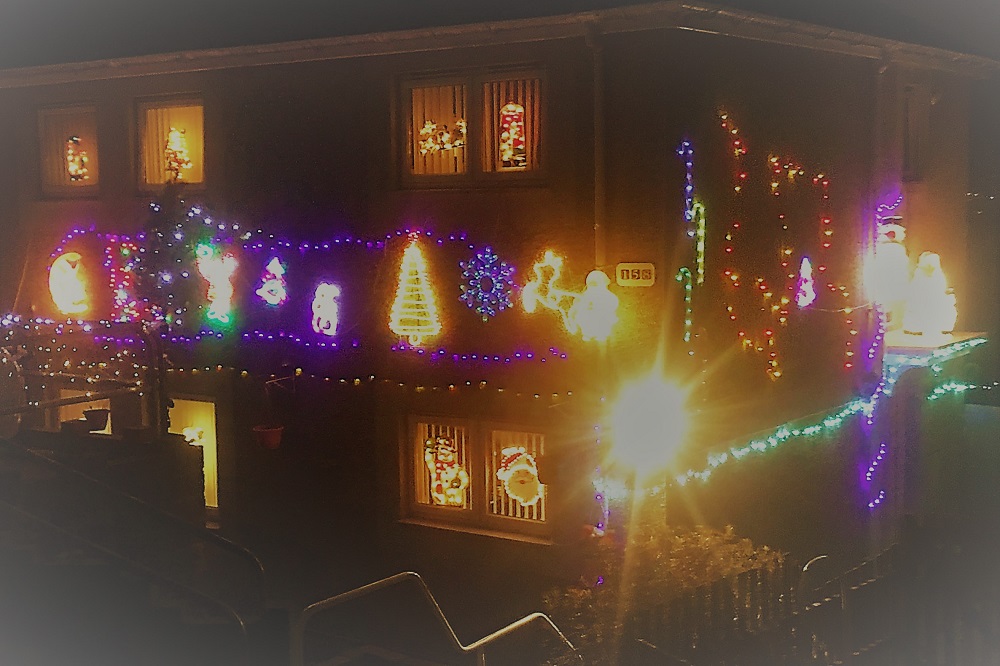
Sarah Morgan Jones
As soon as the Halloween pumpkins get kicked down the road, the oft-spectacular spooky decorations which adorn so many houses get packed up for next year, making way for the festive festoons. The race is on, the battle commences, the ladders and the cordless drill come out and there’ll be no rest till it’s done.
Just last weekend, quite late in proceedings, relatively speaking, I met eyes with my work-away neighbour, as I glanced out of my upstairs window. He was up a ladder attaching stars and reindeer to his house, to entertain his young son…and the rest of our street. And the next.
At the bottom of the close there is a house which has been lit up for weeks, a veritable grotto, possibly visible from space by the time he finishes.
Not just the house but the garden has been transformed, and the hardworking chef in charge mutters pseudo-grudgingly about this all being ‘her’ idea, or for the benefit of his children, but we all know, judging by his in-depth knowledge of the kilowatt-cost-per-unit and how he describes what is yet to come, that he loves a bit of it.
And although there are definitely fewer than normal this year, as the cost of living gnaws away at options for frivolities, and even as the prices at discount emporia such as B&M Bargains have gone up by at least a third, he’s certainly not alone.
In the coming weeks, the estate will flicker to life and light, some houses, like the chef’s, gaining Great Wall status, while others will be more demure delectations, a sprinkling of sparkle in the privet, an illuminated invitation to Santa, a projection of snowflakes on the wall.
These random acts of lightness are often surprising and offer some considerable joy, not least because the council has snuffed out many of the streetlights on the hill to ‘save money’ meaning great swathes of our streets are in eerie darkness.
This darkness, plus the shadows cast by the ubiquitous privet hedges, and the pavement-parked cars and work vans, can make the Hill after sundown, a quietly intimidating prospect, meaning apart from a few, usually male, dog walkers, you won’t come across many pedestrians as the days end.
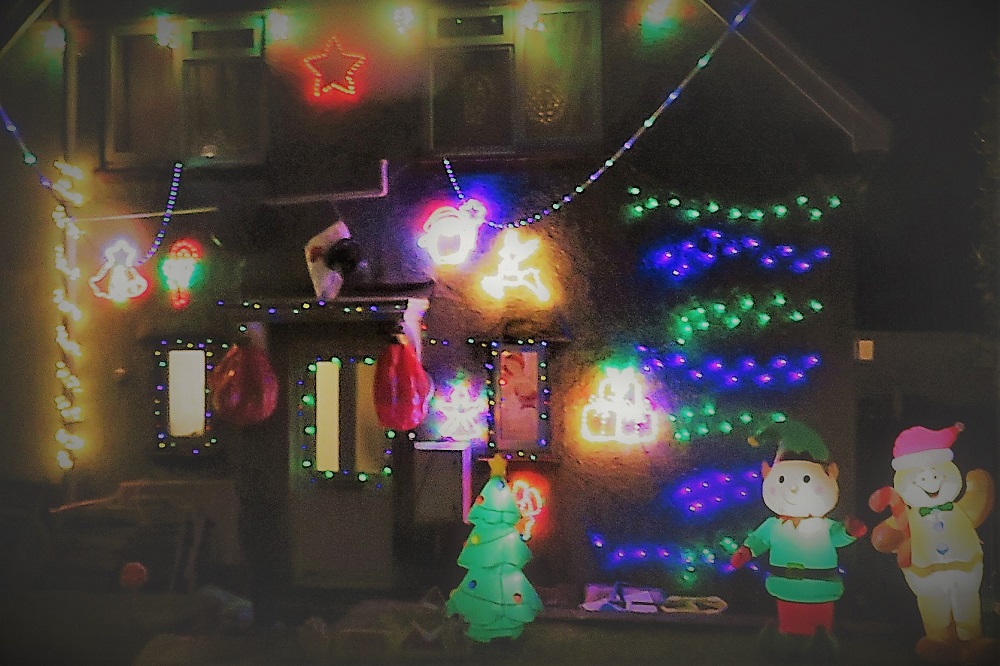
The dragon
When I migrated from the ‘bohemian quarter’ down the hill, I had already been living in Swansea for three decades and like many, had a mixed opinion of the Hill.
Having just lost my home, the downsize required to squeeze my family life into a much smaller house which I was grumpily grateful to rent reasonably from my in-laws, required some cunning planning and a lot of culling, and while we made the space ready inside, I pitched two tents in the garden which first accommodated us, and then stuff which as yet had nowhere to go.
An award-winning estate built in the 1930s, chomping up parcels of farmland, its layout of winding and circular streets and avenues seem to reflect the very contours of the land itself.
Google Earth shows the area as a series of Celt-esque shapes, perhaps, forming the (if you step back and squint) a dragon rearing up, or some other magical beast, on one of the highest outcrops in the city.
If I somehow got atop my roof I would see, to the east(ish), the beacon of Kilvey Hill and the chugging chimneys of Port Talbot, resplendent at dawn. To the west, the gleaming sunset waters of the Loughor estuary, and perhaps even the skeletal iron lighthouse at Whitford Point.
If I turned to the north, and there was no sign of the lurking swirling mists that sometimes swamp the Gors and the valley, I could see the 3M water tower and the fields around Gorseinon where mighty, ancient battles took place.
To the northeast, the eerie, beckoning definition of the Swansea Valley, and on the clearest days the Fans and the foothills of the Beacons, changing moment by moment as they reflect the southern sun.
To the southwest, beyond Mumbles, a sharp, dry evening would open up the Gower coastline and beyond, and if I turned my face south and could see the cliffs of Devon, then I would know that, according to superstition, rain is on its way…and that if I can’t see them, it’s raining.
And all around there would be missing chimneys, as street by street the council remove them, considering them redundant, and with that act, also removing the chance not to be dependent on gas (a few turbines and solar panels up here would go a long way to easing the burden on residents).
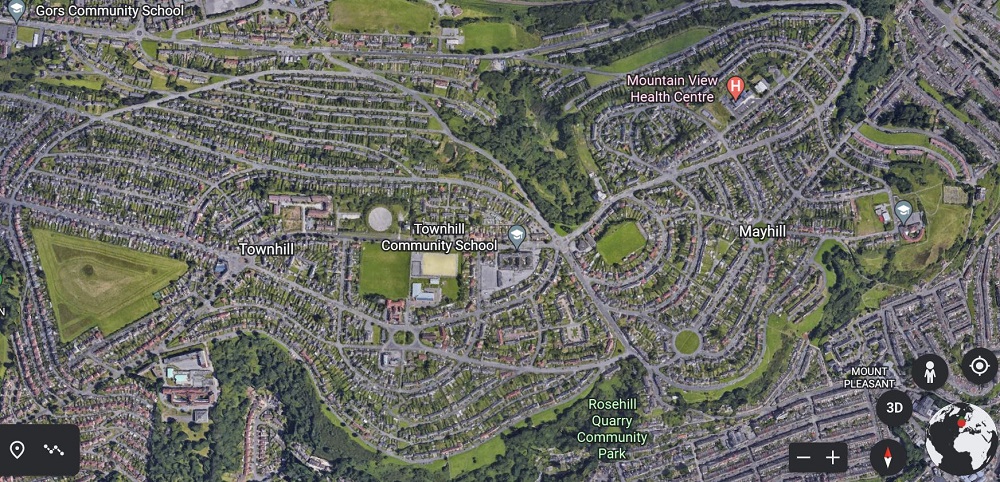
Up in the world
The early days of the estates of the Hill – Townhill, Mayhill and Gors – gave folks from the industrial parts of town the chance to go up in the world, quite literally, to good, functionally sized housing, with space to grow food, and to form little communities around the corner shop hubs and the village green type circles dotted around.
Each area had doctor and a school and a shop and a post office and a pub and the air was fresher, and the light (unless you are just over the north brow of the hill, which can languish in shadow) is brighter.
I know of women who were told by their doctors that if they wanted their child’s asthma to be cured, then they should move up the Hill, quick sharp. Some of those children still live here today.
The design of the Hill houses was varied, reflecting the circle of ‘Competition Houses’ – the prized entries built as a template which form Cadwallader Circle and part of Nicander Parade at the start of Penygraig.
The designs broke away from the dog-leg-shaped houses in endless terraces and streets of Mount Pleasant, North Hill, Greenhill and the Hafod lower down the hill, and offered instead, semi-detached or short terraces of houses in crescents and gardens and parades and avenues.
No more yards, but gardens and hedges of all shapes and sizes, often front and back – no more stepping out of the front room and onto the pavement.
The main artery roads criss-crossing the hill included the old drover’s route from Penclawdd to the town centre, walked daily by cockle women, with a handover point at the Cockett Inn, so they could get back home before dark.
As the development took over increasing swathes of former farmland, a teacher training college was sited on a south-westerly outcrop of Townhill, with an inspiring outlook, accessible to the community for generations as it evolved into the Tech, then Swansea Met (my alma mater) then UWTSD… and which is now being knocked down.
Like the former hospital at Cefn Coed, old college windows which would twinkle oranges and reds at sunset, declaring their presence, are now boarded up by contractors, waiting to be usurped by expensive new builds with breath taking views, priced far out of reach of the locals.
‘Hill of Fear’
When I first came to Swansea in the late 80s, the Hill had a bit of a rep. Joy riders brought notoriety to what the then really local newspaper, the Evening Post, branded with tabloid glee ‘The Hill of Fear’.
Speed bumps were brought in, and huge lumps of rock deposited to created no through roads, in a bid to curtail (and even kill off) this anti-social ‘joy’.
Local Liberal councillor and well known small-of-stature but mightily-motivated Maggie Jones (who posthumously became my mother-in-law) defended and campaigned for the area with such vigour that she was dubbed the Yellow Peril (by dint of her Liberal politics, her hair colour and her diminutive ferocity) by some of her council colleagues.
Undeterred, she and other grass-roots Hill champions paved the way for the area to receive Objective One or Communities First funding and other European support to set up Sure Start centres, community hubs and a library.
She, like many of her generation, was a local wise-woman, a go-to certainty in a crisis, according to her family, and with her old house just down the road by the chef’s Illuminated Wonderland, her memory is still very much alive round here. I only wish I had met her.
I remember walking out on the new dawn of Brexit and looking for the EU funded projects that would soon cease to exist, or at the very least need to look elsewhere for funding.
The effects may not be immediate, but they would be profound, and I did wonder what Maggie and her colleagues would make of those changes.
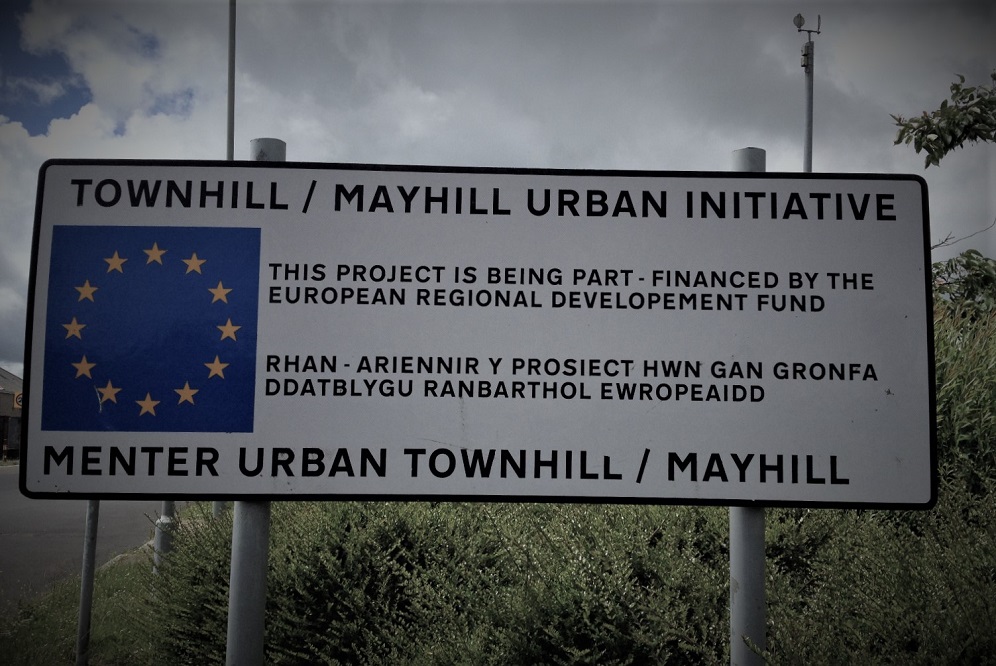
Folklore and frustration
When the old college site closed, ready for the new housing project, so did the much-used straight-ish path down through the campus, through Cwmdonkin Park to the Uplands, to more parks and town and the beach.
As the Pobl housing estate continues apace, there has been a decision not to re-open that path, so permanently, scandalously, closing off a convenient, attractive and accessible pedestrian journey. No short cuts for school kids, no short walk for pram pushers and pensioners, just more dependency on cars or public transport.
There are a few paths off the Hill, the Hundred Steps and the Ravine and past the old Mayhill washing pond, or through Rosehill Quarry or down the main, busy, arterial roads.
But just as planners avoided straight lines in their street maps, so they did with the paths and byways, meaning that there is no direct walking- or bus- routes to any of the nearest Aldi, Lidl or Co-op, and certainly no easy way back if you have a load of family shopping, and some pint-sized family in tow.
There is a Tesco superstore at the terminus of our three circular bus routes, but at £4+ for a ticket and a near guarantee that several of those buses will be pulled from the schedule through the day without warning – or simply go missing in action, it would seem – then car-less shoppers may find their ‘big shop’ an expensive ordeal.
And woe betide you if you need to start work early or go out after six or on a Sunday – work, a night out, or a family outing to the beach – because our scant, inflexible services become a thing of folklore and frustration.
Our local shops very much have a monopoly in their localities and can charge a premium for their wares…if we run out of dog food I know I will be paying twice the price for a tin locally, over the odds for milk and bread, and in one shop round here, if I wanted a tin of corned beef the shopkeeper would look me in the eye without flinching and demand £5.50. I kid you not.
Although part of the population is maybe just starting out up the Hill and may move on to pastures new, many residents have been around for years and are part of the fabric of the place, stitching it through with some vapours of their upbringing in Greenhill or elsewhere.
They know the ropes and the rules, the tall stories and the traditions. The go-to roofer or plumber or spark. The bloke with the keys to the boxing gym. The guy who will strim your garden. The woman who will help in any of life’s rituals from birth to death.
Who to have a word with if you’ve been burgled, how to identify that hooded Herbert caught on CCTV trying the car doors, and why knocking on the door of the Police house, even with an assailant in a headlock, is utterly pointless.
The local funeral director who marches in his finery with a black cane and a sense of theatre ahead of the cortège, that usually leaves from the house.
Distinctive hollering cries of the Rag ‘n’ Bone man can be regularly heard, summoning plenty of householders out with the goods that the scrappies seek, a mutually beneficial service.
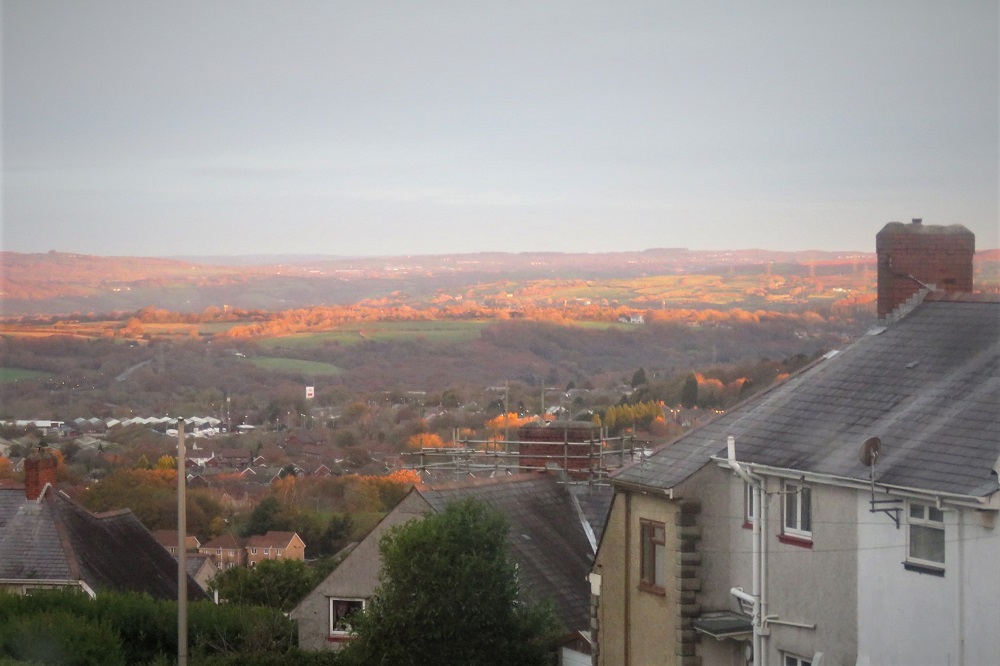
‘Salt of the Earth’
The limelight picks out some names of locals who shone, near and far, in culture, politics and sport – Bad Finger, Spencer Davies, Tommy Jenkins of Cromlech, Paul Allen, Boys from the Hill, rugby players Stuart Davies and Paul Arnold, son of Evans the Shop – politician Nigel Evans, as well as many boxers and footballers and athletes who all emerged from the Hill.
When poet Nigel Jenkins gave the Hill his psycho-geographical consideration in Real Swansea, he went on a walk with local writer and dynamic youth worker Zoe Murphy. They touched on the spirit of the community, the positivity of identity and the robust characters, leaving the reader with a definite ‘salt of the earth’ feel about the place.
It’s easy to get blindly romantic about this, but it most definitely exists. It is evident in the way people know each other, or know of the families; the way in which in streets like mine, women went over to the other side of the hill to help with the clear up in the aftermath of the so-called ‘Mayhill Riots’; the way in which those circular buses act as a vital information exchange when older residents head into town to do their weekly town based chores.
It was evident when I first moved in and all the kids on the street trooped round to my back door en masse to see who had moved in and ask who we were, while they examined us with open curiosity, and the way the cul-de-sac is packed full of playing kids all through the summer, a new lot every couple of years, and the way they all stop and wave and ask ’Where you going? Can I say hello to your dog? Where’ve you been?’
It is evident in the way that some streets have clusters of families, grown up children setting up satellite homes around the mother ship.
And in the way people gather to walk their dogs on the local field and join forces in their indignation about the moped riders who go through phases of tearing up and down the neighbourhood sounding like devil-possessed sewing machines with the pedal rammed on, or the bare-chested broncos riding their bareback, shoeless pie-balds in age-old coming-of-age displays of masculinity and ‘up yours!’
And it’s evident in the way that the roads are often clear of the cars in the daytime, as the plumbers, the sparks and the roofers, the scrappies, the small holders and horse breeders, the cleaners, the carers, the nurses, the teachers, lawyers, army officers, social workers … whoever … are all up and at it from up til down, doing their thing, playing their part.
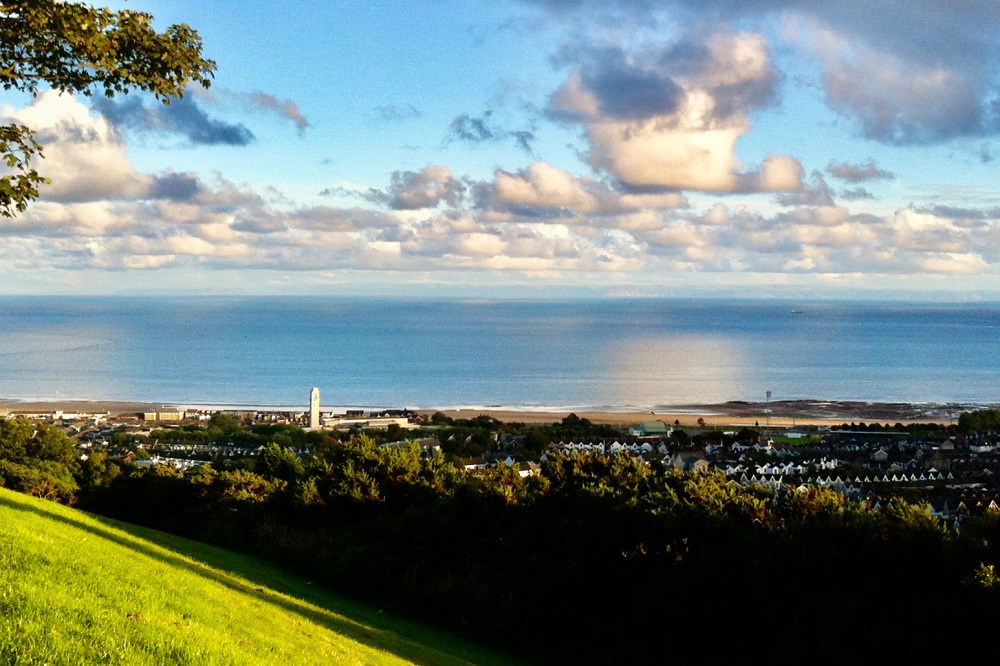
Up yours!
It is easy on a fair day to see all the good up here, and my specs are not so rosie that I can’t see the bad.
On a dreich day when the summit is shrouded in the hedge-tumbling mists while the sun shines at sea level, or when lateral rain dangerously diminishes visibility, or when the buses fail to arrive…and you know that within every street there are people struggling with every obstacle life throws…on those days it can feel a long way up and out up here.
We can be forgotten quickly, and may be hard to reach.
When the council cancelled this year’s firework display down on the seafront, and the usual gathering of hundreds who come to watch for free from Pantycelyn Road was abandoned, I swear there was a better impromptu display in the streets around us than we would have had from the normal vantage point.
So, while the council makes savings on our street lights, and our overpriced bus service is considered optional, and our access routes expendable, and our chimneys are removed, and our college is shifted and our pubs are turned into flats… let’s raise our glasses to the OTT Christmas lights, early, extravagant and exciting, and salute their resounding message.
‘Up Yours!’
Support our Nation today
For the price of a cup of coffee a month you can help us create an independent, not-for-profit, national news service for the people of Wales, by the people of Wales.





That was an amazing read, and i’m deffo joining the ‘up yours’ movement. Loved the history of the hill and your lyrical descriptions. Now I’m off because those fairy lights won’t hang themselves 🎄